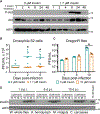Insulin Potentiates JAK/STAT Signaling to Broadly Inhibit Flavivirus Replication in Insect Vectors
- PMID: 31722209
- PMCID: PMC6871768
- DOI: 10.1016/j.celrep.2019.10.029
Insulin Potentiates JAK/STAT Signaling to Broadly Inhibit Flavivirus Replication in Insect Vectors
Abstract
The World Health Organization estimates that more than half of the world's population is at risk for vector-borne diseases, including arboviruses. Because many arboviruses are mosquito borne, investigation of the insect immune response will help identify targets to reduce the spread of arboviruses. Here, we use a genetic screening approach to identify an insulin-like receptor as a component of the immune response to arboviral infection. We determine that vertebrate insulin reduces West Nile virus (WNV) replication in Drosophila melanogaster as well as WNV, Zika, and dengue virus titers in mosquito cells. Mechanistically, we show that insulin signaling activates the JAK/STAT, but not RNAi, pathway via ERK to control infection in Drosophila cells and Culex mosquitoes through an integrated immune response. Finally, we validate that insulin priming of adult female Culex mosquitoes through a blood meal reduces WNV infection, demonstrating an essential role for insulin signaling in insect antiviral responses to human pathogens.
Keywords: Culex quinquefasciatus; DGRP; Drosophila melanogaster; ERK; Kunjin virus; West Nile virus; Zika virus; dengue virus; innate immunity; mosquito.
Copyright © 2019 The Author(s). Published by Elsevier Inc. All rights reserved.
Conflict of interest statement
DECLARATION OF INTERESTS
A.G.G., S.L., L.R.H.A., and C.E.T. have filed a provisional patent application (62/810754) related to the use of insulin receptor agonists.
Figures







References
-
- Arbouzova NI, and Zeidler MP (2006). JAK/STAT signalling in Drosophila: insights into conserved regulatory and cellular functions. Development 133, 2605–2616. - PubMed
-
- Aytug S, Reich D, Sapiro LE, Bernstein D, and Begum N (2003). Impaired IRS-1/PI3-kinase signaling in patients with HCV: a mechanism for increased prevalence of type 2 diabetes. Hepatology 38, 1384–1392. - PubMed
Publication types
MeSH terms
Substances
Grants and funding
LinkOut - more resources
Full Text Sources
Other Literature Sources
Medical
Molecular Biology Databases
Miscellaneous

